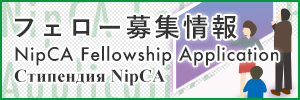Visiting Minsah Kogei Museum
Trip to one of the major Yaeyama islands in Okinawa prefecture – Ishigaki island was full of joy and adventure. Along with visiting Ishigaki City Museum immediately after landing on Naha airport, during our trip there pop up a chance to explore the Museum of Textile of Ishigaki City known as Minsah Kogei Museum.
The day was raining like cats and dogs, but the trip was redesigned to visit the Museum of Textile which locates not far from Ishigaki City. From entrance we were welcomed by kind old lady who mercifully guided whole program of museum for us. From first picture in Figure 1, in the information desk about different ornaments are represented. It was very interesting to know that demonstrated 96 different types of figures are commonly used on dressings of local people has certain meaning. For instance, the very first composition of two vertical bulks represent the bunks (feeders) which means incentives for attraction of material wealth. In other words, when your livestock full and cared, it means household is prosperous and person live in abundance. Also, there are some other meanings representing strengthen and power for male, and happy relationship and health for women. According to workers of museum, the most difficult ornament is the symbol of water. Although meaning of richness has the same features as in Central Asian culture, unfortunately, the water symbol for Ishigaki citizens means disaster and danger, while water is predominantly recognized as purity and serenity by Kazakhs.
The second picture of Figure 1 stands for explanation of 5+4 ornament and the story behind this Minsah pattern belts. First of all, the material pattern that is usually symbolize the feelings of women to her lover. According to brochure of the Museum, Minsah is made by women who wish for men “to live as long as possible”, and can be a symbol of marriage consent, so her wish as “to come as often as possible”.
Figure 1 :Information desks about textile work in museum
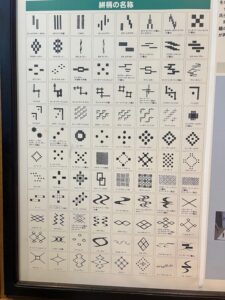

Another type of Minsah belt is Hanaori, which has a special 5 and 4 square compositions as in Figure 2. Five and four patterns have also romantic and symbolic meaning as because, in Japanese:
itsutsu (5 pieces) + yotsu (4 pieces) = itsuyo (forever)
which is playing with words, wishing to be forever together with partner. Moreover, the sum of 5 and 4 is 9, and this number is the greatest number in scale, so people want to multiply their happiness. Another interesting meaning also reveals women wish, so that her husband coming back again with this towel by the same road. Besides that, hanaori has other ornaments such as lizards’ legs for two long sides of the towel playing decorative meaning.
Figure 2 :Presentation of real Minsah belts with ornaments
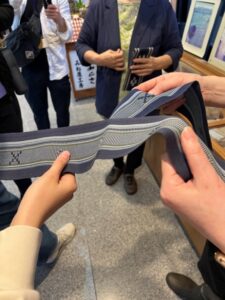
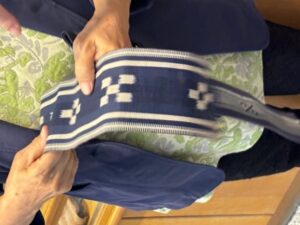
In general, the hand craft towels and belts are made not from cotton, the raw material of textile in Okinawa is tropical plant known as Choma (first picture of Figure 3). The net is stretched from stalk of Choma and the fibers are made out from Choma’s threads. It is very traditional and old style of hand crafting which is still practiced by Ishigaki people.
Figure 3 :Museum items



The culminating part of museum program was wearing Japanese traditional jackets with all groupmates. This jacket has been made by Choma material especially for female and male dressing style. On background scene there are [ おきな ] and [ おうな ] statues that represent a male and female spirits. Overall, the guide in museum was very resourceful and interesting since after those stories with ornaments, I recognize that 5 and 4 symbols are painted on the streets and on souvenirs. To be honest, I was very delighted to see how locals appreciate their traditions and put it into tourism and marketing.
Figure 4 :Dressing Japanese traditional jackets made out of local textile
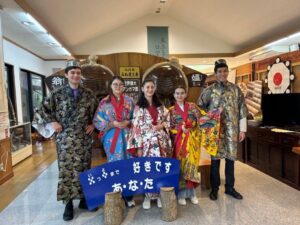
Cycling in Taketomi island
Another great memory from Yaeyama islands was ferry trip to Taketomi islands. I chose to travel around the island by bicycle. Our first destination was Summa Shah, a huge tree at the center of main entrance road. We made some pictures and moved to the post office, which was our second point. There we stopped to organize what should we explore and visit further. Everybody was very enthusiastic and thrilled for further adventure by bike. Not far from post office, we found the tallest ever (in island) Nagomi tower where we shot pictures from up level (see Figure 5). Later after sometime long ride and enjoying picturesque views of island, we visited coasted areas as Nishi-sambashi, Kondoi beach and Kaiji Beach.
Figure 5


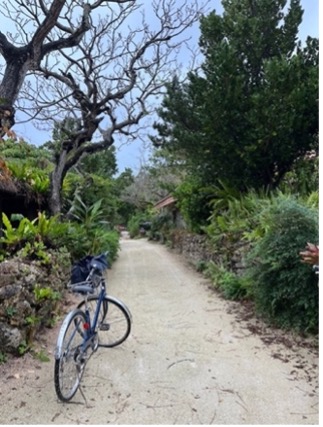
The view from beach to the ocean was unbelievable where we made some group photos and walked along coast line. On returning ride we bumped into famous water buffalo cart, unfortunately because of weather conditions we could not take a tour on it, although we wanted to listen island folk song. Cycle with groupmates gifted special memory for me, because we enjoyed island nature and households, and reached the spots quickly.
Last but not least, I want express my sincere gratitude to my professors, Yamamoto sensei and Yamakawa sensei for organizing a trip and caring about safe and amazing traveling, especially letting us experience cycling on Taketomi island. Thank you for Tanikoshi-sensei who also take care about good traveling and for amazing photos that she shot for us. Okinawa island created adventurous and warm memories for me, and introduced new culture and new knowledge, that I will definitely share with my friends and relatives in Kazakhstan. Furthermore, I recognized how traditions can be coexisted with sustainability and development activities on the island, which was great insights for personal use.


